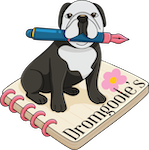(Jeff Abbott is a regular contributor at The Pen Addict. You can find more from Jeff online at Draft Evolution and Twitter.)
Writing things on paper can take many forms and happen for various reasons. Sometimes, it's just to scribble something on a nice piece of paper with a favorite pen to feel the nib on the page and watch the lines appear and breathe. But, sometimes it's for utilitarian purposes – writing a check, filling out a form, or signing a document. In most cases, the utilitarian writing experiences are glum. The paper is atrocious and it makes favorite pens feel broken. I don't recommend pairing exquisite pens with sub-par paper -- no one leaves happy.
I've written about the Emergent Task Planner by David Seah before. The previous review was about the 8.5" x 11" pad, and I love it. With that in mind, I love the 5.8" x 8.5" spiral bound Emergent Task Planner even more. In fact, I've pretty much abandoned the larger pad in favor of the smaller notebook. I believe it's the best of both worlds.
The original Emergent Task Planner (ETP for short) pad uses smooth, fountain pen friendly paper and does a great job for a full-sized pad. But, after using the smaller ETP notebook for several months, it's won me over. Despite the smaller amount of planning and notes space, I love the size and utility of this notebook. It's the size of a regular Rhodia (or Moleskine) notebook, which I've always enjoyed. It's small enough to stay out of the way on my desk, but large enough to adequately plan my day and react to changes that pop up.
The covers are plain black vinyl with no branding and the spirals are doubled and very sturdy. I haven't put the notebook through hell, but I know it could take a lot of abuse if needed.
46 sheets mean you can plan about 3 months of stuff in one book. For me, it ends up being a 4 month book since I don't use it on the weekends.
I remember loving the fact that I could tear off the previous day's sheet in the morning -- felt like the perfect way to mentally start afresh for the coming day -- but I've come to appreciate the utility of having those previous days in the same notebook. There have been several times that I've forgotten exactly what I did throughout the week when it's time to fill out my timesheet, and the archive always helps me remember. It's a planner, but also serves as a logbook. Personally, I love the utility of a simple logbook of tasks, events, and random little things that happen during the day. For many, this is the exact purpose of the Hobonichi planner.
Either way, it's still a fantastic tool that I cannot recommend enough. It keeps me sane during the day, and I don't want to talk about how I feel when I don't have it with me.
The paper in this book is comparable to the full-size pad. It's very friendly to all types of ink and pen. Given the smaller size of the different sections, a finer pen typically works better for me. In fountain pen terms, I like to use a Japanese fine. In other pen terms, a 0.5 mm or smaller is perfect.
If you're looking for a planner, this is a unique and helpful system created by a great guy who provides a lot of information about using the system. Definitely try it out. Heck, you can even try it out before buying one of the notebooks.
(This post contains affiliate links which help support PenAddict.com)












